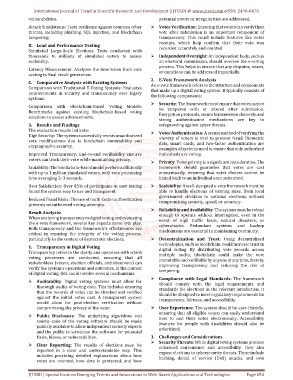Page 660 - Emerging Trends and Innovations in Web-Based Applications and Technologies
P. 660
International Journal of Trend in Scientific Research and Development (IJTSRD) @ www.ijtsrd.com eISSN: 2456-6470
vulnerabilities. potential errors or irregularities are addressed.
Attack Simulations: Tests resilience against common cyber Voter Verification: Ensuring that voters can verify their
threats, including phishing, SQL injection, and blockchain vote after submission is an important component of
tampering. transparency. This could include features like voter
receipts, which help confirm that their vote was
B. Load and Performance Testing recorded accurately and counted.
Simulated Large-Scale Elections: Tests conducted with
thousands to millions of simulated voters to assess Independent Oversight: An independent body, such as
scalability. an electoral commission, should oversee the e-voting
process. This helps to ensure that any disputes, issues,
Latency Measurement: Analyzes the time taken from vote or questions can be addressed impartially.
casting to final result generation.
2. E-Vote Framework Analysis
C. Comparative Analysis with Existing Systems
An e-vote framework refers to the structure and components
Comparison with Traditional E-Voting Systems: Evaluates
that make up a digital voting system. It typically consists of
improvements in security and transparency over legacy
the following components:
systems.
Security: The framework must ensure that votes cannot
Comparison with Blockchain-Based Voting Models: be tampered with or altered after submission.
Benchmarks against existing blockchain-based voting
Encryption protocols, secure transmission channels, and
solutions to assess advancements.
strong authentication mechanisms are key to
3. Results and Findings safeguarding against cyber threats.
The evaluation results indicate: Voter Authentication: A secure method of verifying the
High Security: The system successfully resists unauthorized identity of voters is vital to prevent fraud. Biometric
vote modifications due to blockchain immutability and data, smart cards, and two-factor authentication are
cryptographic security.
examples of systems used to ensure that only authorized
Improved Transparency: End-to-end verifiability ensures individuals are voting.
voters can track their vote while maintaining privacy.
Privacy: Voter privacy is a significant consideration. The
Scalability: The blockchain-based model performs efficiently framework should guarantee that votes are cast
with up to 1 million simulated voters, with vote processing anonymously, ensuring that voter choices cannot be
time averaging 2–3 seconds. linked back to an individual once submitted.
User Satisfaction: Over 85% of participants in user testing Scalability: A well-designed e-vote framework must be
found the system easy to use and transparent. able to handle elections of varying sizes, from local
government elections to national elections, without
Reduced Fraud Risks: The use of multi-factor authentication
compromising security, speed, or accuracy.
prevents unauthorized voting attempts.
Reliability and Availability: The system must be robust
Result Analysis:
enough to operate without interruption, even in the
When analyzing transparency in digital voting and evaluating
event of high traffic loads, natural disasters, or
the e-vote framework, several key aspects come into play.
cyberattacks. Redundant systems and backup
Both transparency and the framework’s effectiveness are
mechanisms are essential in maintaining continuity.
critical in ensuring the integrity of the voting process,
particularly in the context of democratic elections. Decentralization and Trust: Using decentralized
technologies, such as blockchain, could increase trust in
1. Transparency in Digital Voting digital voting. By distributing vote records across
Transparency refers to the clarity and openness with which multiple nodes, blockchain could make the vote
voting processes are conducted, ensuring that all immutable and verifiable by anyone at any time, thereby
stakeholders (voters, election officials, and observers) can improving transparency and reducing the risk of
verify the system's operations and outcomes. In the context tampering.
of digital voting, this could involve several mechanisms:
Compliance with Legal Standards: The framework
Auditability: Digital voting systems must allow for should comply with the legal requirements and
thorough audits of voting data. This includes ensuring standards for elections in the relevant jurisdiction. It
that the records of votes can be checked and verified should be designed to meet regulatory requirements for
against the initial votes cast. A transparent system transparency, fairness, and accessibility.
would allow for post-election verification without
compromising the privacy of the voter. User Experience: The system should be user-friendly,
ensuring that all eligible voters can easily understand
Public Disclosure: The underlying algorithms and
how to cast their votes electronically. Accessibility
source code of the voting software should be made
features for people with disabilities should also be
publicly available to allow independent security experts
prioritized.
and the public to scrutinize the software for potential
flaws, biases, or vulnerabilities. 3. Challenges and Considerations
Security Threats: While digital voting systems promise
Clear Reporting: The results of elections must be
enhanced convenience and accessibility, they also
reported in a clear and understandable way. This
expose elections to cybersecurity threats. These include
includes providing detailed explanations about how
hacking, denial of service (DoS) attacks, and vote
votes are counted, how data is protected, and how
IJTSRD | Special Issue on Emerging Trends and Innovations in Web-Based Applications and Technologies Page 650

